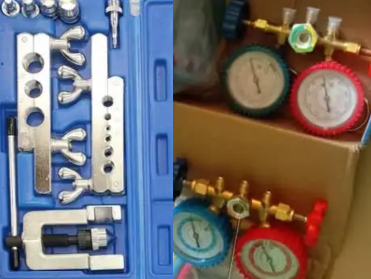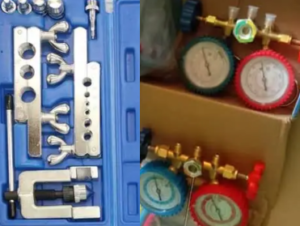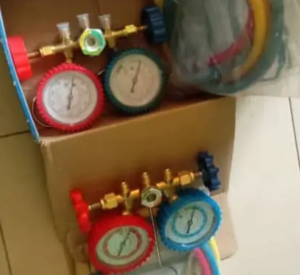The hot weather can be unbearable without air conditioning. Installing an air conditioning unit can be a daunting task for many homeowners, especially if you don’t have the right tools. It’s essential to have the right tools to ensure that the installation process is smooth and efficient. In this blog post, we’ve compiled a comprehensive guide to the ten must-have complete tools for air conditioning installation. We’ll take you through each tool, explaining its purpose and the role it plays in the installation process. By the end of this post, you’ll have a better understanding of the tools needed for air conditioning installation and be ready to tackle the job with confidence. Whether you’re a DIY enthusiast or a professional, this guide will help ensure that your next air conditioning installation is a success.
When it comes to air conditioning, installation is a critical step that should not be overlooked. Proper installation not only ensures optimal performance and energy efficiency but also guarantees the longevity of your air conditioning system. Whether you’re a homeowner looking to keep your living space comfortable or a business owner aiming to provide a pleasant environment for your employees and customers, investing in a professional installation is essential.
One of the key reasons why proper air conditioning installation is crucial is its impact on energy efficiency. An inadequately installed system can lead to air leaks, improper ductwork, or poor insulation, all of which contribute to energy wastage. This, in turn, results in higher utility bills and a negative impact on the environment. On the other hand, a well-installed air conditioning system will be properly sealed, insulated, and calibrated to ensure maximum energy efficiency, helping you save both money and resources in the long run.
Proper installation plays a vital role in the overall performance and functionality of your air conditioning unit. An accurately installed system will effectively cool or heat your space, providing consistent and comfortable temperatures throughout. On the contrary, an improperly installed unit may struggle to maintain the desired temperatures, leading to hot or cold spots, frequent breakdowns, and inefficient operation. By investing in professional installation, you can ensure that your air conditioning system operates at its peak performance, delivering optimal comfort all year round.
Additionally, proper installation ensures the safety of your property and its occupants. Faulty installations can pose serious risks, such as electrical hazards, refrigerant leaks, or even fire hazards. A professional installer will have the knowledge and expertise to handle these potential risks and ensure that your air conditioning system is installed according to safety standards and regulations. This not only protects your investment but also provides peace of mind knowing that your system is installed correctly and operates safely.
Below are the listed number of Air conditioning tools for proper installations:
1. Refrigerant Manifold Gauge Set
One of the must-have tools in your arsenal is a refrigerant manifold gauge set. This tool plays a crucial role in ensuring proper refrigerant levels and pressures within the system.
A refrigerant manifold gauge set consists of three gauges – high-pressure gauge, low-pressure gauge, and a compound gauge. These gauges are designed to measure the pressure of the refrigerant at various points in the system. By connecting the gauges to the corresponding pressure ports on the air conditioning unit, you can accurately monitor and adjust the refrigerant levels.
The high-pressure gauge measures the pressure of the refrigerant on the high side of the system, typically after it has been compressed by the compressor. This gauge helps you ensure that the pressure is within the recommended range, preventing any potential damage to the system or compressor.
On the other hand, the low-pressure gauge measures the pressure on the low side of the system, before the refrigerant enters the compressor. This gauge allows you to determine if there are any issues with the suction line or the refrigerant flow, ensuring optimal performance of the air conditioning unit.
Lastly, the compound gauge combines the readings from both the high and low-pressure gauges to provide a comprehensive view of the system’s overall pressure. This gauge is especially useful when troubleshooting any potential issues or diagnosing problems with the air conditioning system.
Investing in a high-quality refrigerant manifold gauge set is crucial for any air conditioning installation project. It not only helps you maintain precise refrigerant levels but also ensures the system’s efficiency and longevity. Make sure to choose a gauge set that is compatible with the refrigerant used in your specific air conditioning unit and follow the manufacturer’s instructions for proper usage and maintenance. With this essential tool in your toolkit, you’ll be well-equipped to tackle any air conditioning installation with confidence.
2. Vacuum Pump
A vacuum pump is an essential tool used during the installation process to remove any moisture and air from the refrigerant lines. This is important because any moisture or air left in the lines can cause system inefficiency, reduce cooling performance, and potentially damage the compressor.
A high-quality vacuum pump ensures a thorough evacuation of the system, creating a vacuum that allows for the proper charging of refrigerant. It also helps to prevent any contaminants from entering the system, which could lead to corrosion or blockages.
When selecting a vacuum pump, there are several factors to consider. First, you want to choose a pump with a sufficient CFM (cubic feet per minute) rating to handle the size and capacity of the air conditioning system you are installing. A higher CFM rating means the pump can evacuate the system faster, saving you time and energy. Durability is key when it comes to a vacuum pump. Look for a pump that is built to withstand the demands of regular use, with features such as a sturdy housing and reliable seals to prevent leaks.
Another important consideration is the pump’s ultimate vacuum level. The lower the ultimate vacuum level, the better the pump’s ability to remove moisture and air from the system. Look for a pump that can achieve a deep vacuum level to ensure optimal performance.
Importantly, consider the noise level of the pump. While it may not be the most crucial factor, having a quieter vacuum pump can make the installation process more comfortable, especially in residential settings.
3. Tubing Cutter
When it comes to air conditioning installation, one tool that should be in every HVAC technician’s arsenal is a tubing cutter. This versatile tool is essential for cutting copper tubing with precision and ease.
Whether you’re working on residential or commercial installations, a tubing cutter is a must-have. It allows you to accurately cut copper tubing to the desired length, ensuring a clean and secure connection. This is crucial for maintaining the efficiency and functionality of the air conditioning system.
The design of a tubing cutter typically consists of a sharp cutting wheel that rotates around the tube, creating a clean, smooth cut. Many models also feature a retractable blade for added safety and convenience.
Using a tubing cutter eliminates the need for hacksaws or other less precise cutting tools. It ensures that the tubing ends are square and free from burrs, which can hinder proper fitting and sealing. With a tubing cutter, you can achieve professional-grade results every time.
Whether you’re installing new air conditioning systems or replacing components, having a tubing cutter in your toolkit will save you time and effort. It allows you to work more efficiently, reducing the risk of leaks and ensuring a reliable and long-lasting installation.
With this essential tool at your disposal, you’ll be well-equipped to tackle any air conditioning installation with confidence.
4. Flaring Tool
A flaring tool is used to create a precise and reliable flare on the end of copper tubing used in air conditioning systems. This flare serves as a connection point for other components such as fittings and valves. Without a proper flare, leaks can occur, leading to inefficient cooling and potential damage to the system.
The flaring tool consists of a clamp and a flare cone. The copper tubing is inserted into the clamp, secured tightly, and the flare cone is then screwed onto the tubing. As the cone is tightened, it expands the end of the tubing, creating a uniform flare.
There are various types of flaring tools available, including manual and hydraulic options. Manual flaring tools require hand pressure to create the flare, while hydraulic ones use hydraulic pressure for a more consistent and precise flare.
Using a flaring tool not only ensures a secure connection but also saves time and effort during installation. It allows technicians to quickly and accurately create flares, enabling them to move on to the next steps of the installation process efficiently.
Flaring tool provides HVAC technicians with the ability to create strong and leak-free connections, ensuring the optimal performance of the system. So, make sure to include a reliable flaring tool in your toolkit when embarking on any air conditioning installation project.
5. Pipe Bender
The pipe bender is a crucial tool for manipulating copper pipes, which are commonly used in air conditioning systems. It allows HVAC technicians to create smooth and precise bends in the pipes, ensuring that they fit perfectly into the designated spaces and follow the required specifications.
One of the primary benefits of using a pipe bender is that it eliminates the need for fittings and connectors, which can potentially lead to leakages and inefficiencies in the system. By bending the pipes to the required angles and shapes, the overall integrity of the air conditioning system is maintained, promoting optimal performance and energy efficiency.
Pipe benders come in various sizes and styles, catering to different pipe diameters and bending requirements. It is important to choose a pipe bender that is suitable for the specific needs of your air conditioning installation project. Consider factors such as the pipe diameter, material, and the desired bend angles when selecting the right pipe bender for the job.
Using a pipe bender requires skill and precision to ensure that the bends are smooth and free from kinks or deformities. HVAC technicians must have proper training and experience in using this tool to achieve professional results. Additionally, it is crucial to follow safety guidelines and wear appropriate protective gear when operating a pipe bender to prevent any accidents or injuries.
6. Torque Wrench
A torque wrench is a precision tool that allows for the accurate tightening of fasteners, such as bolts and nuts, to a specific torque value. This is crucial in air conditioning installation as improper tightening can lead to leaks, inefficiencies, and even equipment failure.
The torque wrench provides a level of control and consistency that is unmatched by traditional wrenches or handheld tools. It allows HVAC technicians to apply the precise amount of torque required by the manufacturer’s specifications, ensuring that all fasteners are tightened to the correct tension.
Not only does the torque wrench help to prevent damage to the equipment, but it also plays a role in ensuring the safety of both the technician and the end user. Over-tightening can cause stress on the components, while under-tightening can result in loose connections that may pose a risk of system failure.
When selecting a torque wrench for air conditioning installation, it is important to consider factors such as the torque range, accuracy, and ease of use. Opting for a high-quality wrench with a wide range of torque settings will provide versatility for various applications.
Torque wrench is a must-have tool for air conditioning installation projects. Its precision, control, and ability to achieve accurate torque values are vital in ensuring the longevity and efficiency of the system. By investing in a reliable torque wrench, HVAC technicians can confidently tackle any installation task with confidence and professionalism.
7. Digital Multimeter
A digital multimeter is a versatile device that allows technicians to measure various electrical parameters, making it an essential tool for troubleshooting and diagnosing issues during the installation process. With its digital display and precise measurements, it provides accurate readings of voltage, current, resistance, and continuity.
During air conditioning installation, a digital multimeter can be used to check the voltage supply, ensuring that the electrical connections are properly functioning. It can also help in identifying any faulty components or wiring that may cause issues in the system.
Moreover, a digital multimeter can assist in testing the capacitor and motor for proper functioning, as well as checking the continuity of wires and circuits to ensure they are properly connected.
With its compact size and easy-to-use interface, a digital multimeter offers convenience and efficiency to HVAC technicians. Its ability to provide accurate readings and diagnose electrical problems makes it an indispensable tool for any air conditioning installation project.
8. Leak Detection Kit
A leak in the air conditioning system can lead to decreased cooling performance, increased energy consumption, and potential damage to the unit itself. That’s why investing in a reliable leak detection kit is essential for any HVAC technician or DIY enthusiast.
Leak detection kits typically consist of a handheld electronic leak detector, leak detection dye, and UV light. The handheld electronic leak detector uses advanced sensor technology to detect refrigerant leaks quickly and accurately. It can detect leaks in various parts of the system, including coils, fittings, valves, and tubing.
In addition to the electronic leak detector, leak detection dye is another valuable component of the kit. The dye is added to the air conditioning system, and when a leak is present, it will escape along with the refrigerant. By shining a UV light on the system, the dye will fluoresce, making it easy to pinpoint the source of the leak.
Using a leak detection kit not only helps identify existing leaks during installation but also allows for proactive leak detection during routine maintenance. Regularly checking for leaks ensures that potential issues are addressed promptly, preventing larger problems down the line.
When selecting a leak detection kit, it’s important to choose one that is compatible with the refrigerant used in your specific air conditioning system. Different refrigerants require different detection methods, so be sure to check the specifications of the kit to ensure it aligns with your needs.
9. Pipe Insulation Cutter
The pipe insulation cutter is designed with a sharp blade that easily slices through the insulation material without causing any damage to the underlying pipe. This is essential as a clean cut will prevent any gaps or spaces in the insulation, which can compromise the overall performance and efficiency of the air conditioning system.
Using a pipe insulation cutter is also a time-saving tool, as it allows for quick and accurate cuts without the need for additional tools or excessive effort. This is especially beneficial when working on larger installations or projects that require multiple cuts.
Additionally, a pipe insulation cutter is ergonomically designed for ease of use, with comfortable handles that provide a secure grip and reduce hand fatigue during prolonged use. This ensures that you can work efficiently and comfortably, without compromising on the quality of the cuts.
Having a pipe insulation cutter as part of your toolkit for air conditioning installation is essential for achieving professional results. It not only simplifies the cutting process but also ensures that the insulation is properly installed, contributing to the overall performance and longevity of the air conditioning system.
10. Fin Comb
A fin comb is a simple yet effective tool designed to straighten bent or damaged fins on the condenser or evaporator coils. These fins are delicate and can easily become bent or misshapen, which can affect the airflow and overall performance of the air conditioning unit.
Using a fin comb is a straightforward process. The tool typically features a series of different-sized teeth that match the spacing of the fins on the coils. By gently sliding the fin comb through the fins, you can straighten them out and restore proper airflow.
Not only does a fin comb improve the efficiency of the air conditioning unit, but it also helps to prevent further damage. Bent fins can cause the air conditioner to work harder, leading to increased energy consumption and potential system failure.
Having a fin comb as part of your HVAC toolkit is essential, especially when working with older or heavily used air conditioning units. By regularly inspecting and straightening the fins, you can prolong the lifespan of the equipment and ensure optimal performance.
Bonus Tips for a Successful Air Conditioning Installation
These tips can help ensure that your new AC unit operates efficiently, providing optimal comfort in your space.
Firstly, before beginning the installation process, it’s crucial to carefully measure the area where you plan to install the unit. This will ensure that you choose the right size and capacity for your specific needs. Installing an AC unit that is too small will struggle to cool the space, while one that is too large will lead to excessive energy consumption and inefficient cooling.
Secondly, proper insulation is key to maximizing the effectiveness of your air conditioning system. Insulating the walls, floors, and ceilings of the area being cooled can help prevent cool air from escaping and hot air from infiltrating. This will not only enhance the cooling efficiency but also save energy and reduce utility costs.
In addition, it’s important to consider the placement of the AC unit itself. Ensure that it is positioned away from direct sunlight, heat-emitting appliances, or any sources of potential obstruction. This will allow the unit to operate at its full potential and prevent unnecessary strain on the system.
Furthermore, regular maintenance is essential for the longevity and efficient operation of your air conditioning system. Make sure to clean or replace the air filters regularly to ensure proper airflow and remove any accumulated dust or debris. Additionally, schedule professional maintenance checks at least once a year to identify any potential issues and keep your system running smoothly.
Don’t forget to familiarize yourself with the manufacturer’s instructions and guidelines for installation and maintenance. Following these guidelines will not only ensure a successful installation but also maintain the validity of any warranties associated with your AC unit.
By following these bonus tips, you can ensure a successful air conditioning installation that provides optimal cooling and comfort for years to come.
In conclusion, investing in the right tools for air conditioning installation is crucial for a successful and efficient process. As we have discussed throughout this guide, the proper tools not only make the installation easier but also ensure safety and accuracy.
By having a set of must-have tools specifically designed for air conditioning installation, you can save time and effort, avoid unnecessary complications, and achieve optimal results. These tools include but are not limited to refrigerant gauges, tubing cutters, manifold sets, vacuum pumps, and torque wrenches.
Remember, quality should never be compromised when it comes to selecting your tools. Investing in high-quality, durable tools may require a larger upfront cost, but they will undoubtedly pay off in the long run with their reliability and longevity.




